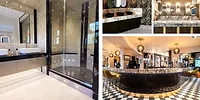Taking the Heat
Zircotec has developed a durable, heat-resistant ceramic coating that provides benefits in a range of applications. From its nuclear beginnings, the coating is finding increasing uses in the automotive industry, the medical sector and beyond.
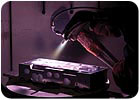
Tucked in the hills of rural Oxfordshire, away from the tourist grabbing charms of the famous university city, a flame burns at 36,000°F.
An unassuming building at the back of a former government research center is home to Zircotec, a technology spin-off from the nuclear industry. Although the UK’s enthusiasm for nuclear power has waned, the spark of creativity that its development fostered still glows. Zircotec is one example of this creativity; the company has developed a durable, heat-resistant ceramic coating that provides benefits in a range of applications. From its nuclear beginnings, the coating is finding increasing uses in the automotive industry, the medical sector and beyond.
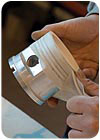
The primary applications of Zircotec’s coating so far have been in the motorsports sector. “We were approached by Prodrive [which runs the Subaru World Rally Team], back in 1994,” says Zircotec’s general manager Andy McCabe. “World Rally Cars don’t only run in snow and ice; they also have to race in the desert, and their drivers were getting hot. We found that putting our coating on the exhaust pipe, not only under the hood but running under the entire length of the car, helped lower the passenger cabin temperature between 6 and 8°C [11 and 14°F].”
The World Rally Championship is probably the most challenging area of motorsports for any coating. All components are exposed to extremes of temperature and vibration and experience a reasonable likelihood of being hit by large rocks. In spite of these challenges, the coating performed consistently, proving itself to be highly durable, as well as effective.
From this initial application, word spread about the advanced ceramic coating, leading to the use of the system in the British Touring Car Championship and, subsequently, Formula One. The coating is now used by almost half of the teams on the F1 grid.
In addition to driver comfort, coating hot components provides many other advantages. For example, Formula One teams extensively use a carbon fiber composite. These composite components are light but can be susceptible to delamination when exposed to high temperatures. Formula One teams have found that by coating the exhaust components of their cars, carbon fiber composites can be used much closer to the exhaust than would otherwise be possible, allowing a greater number of components to be made from carbon fiber and reducing the need for heat shielding. This benefit also gives designers greater flexibility to design vehicles that are as aerodynamic as possible, with the bodywork following the underlying structures much more closely. Plasma spray coating the fiber components with the advanced ceramic finish has allowed carbon fiber to replace metal in areas of a vehicle that previously would have been considered too hot for the use of this material.
The effect of coating the exhaust components extends beyond simply protecting heat-sensitive parts. Ensuring that the thermal energy stays where it is supposed to can help engines optimize their performance. Retaining heat energy in the exhaust system allows the gases within the exhaust to move faster, reducing back-pressure on cylinders and helping to increase engine efficiency. Protecting air intakes from locally generated heat also means the engine receives denser, more oxygen-rich air, helping to boost performance further. A 9°F (5°C) drop in air intake temperature boosts power output by around 1%. The 54°F (30°C) reductions seen by users of the advanced ceramic coating indicate that 6% increases in horsepower are possible. In the competitive world of motorsports, such increases are a significant improvement with little additional cost.
Many of these benefits derive not just from the thermal insulation properties of the zirconia-based coating, but also from the application method. Rather than being painted on, the ceramic is ionized in a high-powered electric arc so that fine, molten particles can be sprayed onto a surface. The result is a coating that binds much more effectively to the parts being sprayed than the wraps and paints used in the past.
To create a highly resilient coating, all parts are first degreased and shot-blasted to provide a clean and predictable surface. A nickel-based coat is plasma-sprayed to add roughness so that the ceramic coating can bind to the surface as firmly as possible. The final result is a highly uniform coating of between 300 and 350 microns (12 to 14 mils) thickness, with around a third of that made up by the undercoat. The effect on the component’s weight is an additional 1.6 kg (3.5 lb) per square meter.
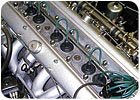
A variety of finishes have been developed - including black, dark gray and silver - to extend the use of the ceramic coating in this application. The silver, for instance, has been used to coat the manifolds of a classic Aston Martin DB4 to protect the rest of the engine bay. Modern fuels tend to generate much higher temperatures than the blends used in the 1960s; as a result, classic components are subject to much greater thermal loads than would have been anticipated at the time of their design. The ceramic coating helps ensure that the finish of a carefully restored engine bay isn’t immediately destroyed the first time the owner’s right foot gets twitchy.
In addition to a biocompatible titanium coating, the company developed a coating incorporating hydroxyapatite, a substance similar to human bone. A textured layer of hydroxyapatite creates a structure that bone can grow into, creating an even stronger bond between the implant and the damaged bone.
Zircotec also has developed a spraying method that allows it to produce free-standing ceramic components in complex shapes, including components used in the manufacture of optical fibers. The fibers themselves are created by drawing glass through an electromagnetic-induction furnace at high temperatures. Zircotec’s ceramics are used to create the central element of these furnaces: the susceptors that conduct the heat of the furnace through to the glass. This requires the ability to withstand thermal shock as they are heated to around 3632°F (2000°C) and allowed to cool again.
The long-term vision of the company involves building on this motorsports work, as well as playing a greater role in the mainstream automotive industry. As fuel prices and environmental concerns push major car makers to look for ways to increase vehicle efficiency, Zircotec is working to make its ceramic coatings part of that effort.
One avenue it is investigating is the coating of diesel particulate filters. These catalytic converters, used to reduce the soot output from diesel engines, need to maintain relatively high temperatures to work effectively. The company is investigating whether the components would work more effectively, or require less of their expensive catalytic materials, if they could be kept nearer their optimal operating temperatures. Any reduction in cost or increase in effectiveness would help diesel engines to comply with the increasingly strict emissions legislation being introduced in both the U.S. and Europe.
The coating also could benefit conventional gasoline engines. For example, coating pistons and cylinders could maximize the use of heat within the cylinder, while coating the components of smaller, forced-induction engines could help ensure that as much thermal energy as possible reaches the turbo charger.
Additional applications are likely as the demand for durable, high-performance, heat-resistant components continues to increase.
For more information about ceramic coatings, e-mail enquiries@zircotec.co.uk or visit www.zircotec.com.
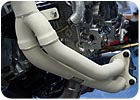
Litchfield Imports is a company that began by bringing Japan-only performance cars into the UK. In recent years, however, it decided to develop its own version of the popular Subaru Impreza.
The Litchfield Type 25 features a number of enhancements over the already fast Spec-C works car, including a more powerful engine codeveloped with performance engineering company Cosworth. This new engine highlighted some peculiarities of the Impreza design, though. Managing Director Iain Litchfield explains: “The engine doesn’t like heat. The intercooler sits on top of the engine, rather than down at the front by the radiator. This is fine when you’re driving along but if you sit in traffic, [the engine] doesn’t get the air flow.”
The intercooler, which cools the air compressed by the turbo before it enters the engine, depends on there being a difference in temperature between the compressed air inside the intercooler and the air passing around it. Heat from the engine prevents the intercooler from working effectively, meaning that warmer, less dense, less oxygen-rich air enters the engine, reducing engine power.
However, Litchfield was determined to stick to the original engine-bay layout as closely as possible. “This is a ‘halo’ product for us; we wanted it to be as OEM-looking as possible,” he says.
Having heard about the use of Zircotec’s coating on World Rally Championship Imprezas, Litchfield decided to try the coating on the Type 25. He found that coating the up- and down-pipes, to and from the turbocharger, helps keep the entire engine bay cool. An added benefit is that more of the energy in the hot exhaust gases leaving the engine reaches the turbo, rather than being radiated away from the up-pipe. “The more heat you can keep in the system, the faster the turbo will spool up, making the car more responsive. We’re finding it’s bringing the turbo up to speed 300 or 400 rpm sooner, which you can really feel in the crispness of the throttle response.”

Rather than being painted on, the ceramic is ionized in a high-powered electric arc so that fine, molten particles can be sprayed onto a surface. The result is a coating that binds much more effectively to the parts being sprayed than the wraps and paints used in the past.
Tucked in the hills of rural Oxfordshire, away from the tourist grabbing charms of the famous university city, a flame burns at 36,000°F.
An unassuming building at the back of a former government research center is home to Zircotec, a technology spin-off from the nuclear industry. Although the UK’s enthusiasm for nuclear power has waned, the spark of creativity that its development fostered still glows. Zircotec is one example of this creativity; the company has developed a durable, heat-resistant ceramic coating that provides benefits in a range of applications. From its nuclear beginnings, the coating is finding increasing uses in the automotive industry, the medical sector and beyond.

A spray-coated piston is carefully unmasked following the spraying process.
Thermal Management
Thermal management is fundamental to automotive engine design, since the internal combustion engine is a thermodynamic system rendered in metal. Ceramic coatings have been used in the automotive field before, to retain heat within specific subsystems or to protect components and operators from excessive temperatures.The primary applications of Zircotec’s coating so far have been in the motorsports sector. “We were approached by Prodrive [which runs the Subaru World Rally Team], back in 1994,” says Zircotec’s general manager Andy McCabe. “World Rally Cars don’t only run in snow and ice; they also have to race in the desert, and their drivers were getting hot. We found that putting our coating on the exhaust pipe, not only under the hood but running under the entire length of the car, helped lower the passenger cabin temperature between 6 and 8°C [11 and 14°F].”
The World Rally Championship is probably the most challenging area of motorsports for any coating. All components are exposed to extremes of temperature and vibration and experience a reasonable likelihood of being hit by large rocks. In spite of these challenges, the coating performed consistently, proving itself to be highly durable, as well as effective.
From this initial application, word spread about the advanced ceramic coating, leading to the use of the system in the British Touring Car Championship and, subsequently, Formula One. The coating is now used by almost half of the teams on the F1 grid.
In addition to driver comfort, coating hot components provides many other advantages. For example, Formula One teams extensively use a carbon fiber composite. These composite components are light but can be susceptible to delamination when exposed to high temperatures. Formula One teams have found that by coating the exhaust components of their cars, carbon fiber composites can be used much closer to the exhaust than would otherwise be possible, allowing a greater number of components to be made from carbon fiber and reducing the need for heat shielding. This benefit also gives designers greater flexibility to design vehicles that are as aerodynamic as possible, with the bodywork following the underlying structures much more closely. Plasma spray coating the fiber components with the advanced ceramic finish has allowed carbon fiber to replace metal in areas of a vehicle that previously would have been considered too hot for the use of this material.
The effect of coating the exhaust components extends beyond simply protecting heat-sensitive parts. Ensuring that the thermal energy stays where it is supposed to can help engines optimize their performance. Retaining heat energy in the exhaust system allows the gases within the exhaust to move faster, reducing back-pressure on cylinders and helping to increase engine efficiency. Protecting air intakes from locally generated heat also means the engine receives denser, more oxygen-rich air, helping to boost performance further. A 9°F (5°C) drop in air intake temperature boosts power output by around 1%. The 54°F (30°C) reductions seen by users of the advanced ceramic coating indicate that 6% increases in horsepower are possible. In the competitive world of motorsports, such increases are a significant improvement with little additional cost.
Many of these benefits derive not just from the thermal insulation properties of the zirconia-based coating, but also from the application method. Rather than being painted on, the ceramic is ionized in a high-powered electric arc so that fine, molten particles can be sprayed onto a surface. The result is a coating that binds much more effectively to the parts being sprayed than the wraps and paints used in the past.
To create a highly resilient coating, all parts are first degreased and shot-blasted to provide a clean and predictable surface. A nickel-based coat is plasma-sprayed to add roughness so that the ceramic coating can bind to the surface as firmly as possible. The final result is a highly uniform coating of between 300 and 350 microns (12 to 14 mils) thickness, with around a third of that made up by the undercoat. The effect on the component’s weight is an additional 1.6 kg (3.5 lb) per square meter.

The ceramic coating can protect the engine bay without affecting appearance. Shown are silver coated exhaust manifolds on a classic Aston Martin straight six engine.
A Classic Finish
The use of this advanced coating has not been restricted to the futuristic, high-tech world of motorsports. The coating’s cream finish also is becoming popular with restorers of classic racing cars of the 1950s and 60s, which would have originally featured asbestos-based paints as a safety feature on their exposed exhaust pipes. Users have found the coating offers a superior level of heat shielding and greatly improved durability, without impacting the original appearance of the vehicle.A variety of finishes have been developed - including black, dark gray and silver - to extend the use of the ceramic coating in this application. The silver, for instance, has been used to coat the manifolds of a classic Aston Martin DB4 to protect the rest of the engine bay. Modern fuels tend to generate much higher temperatures than the blends used in the 1960s; as a result, classic components are subject to much greater thermal loads than would have been anticipated at the time of their design. The ceramic coating helps ensure that the finish of a carefully restored engine bay isn’t immediately destroyed the first time the owner’s right foot gets twitchy.
Not Just Automotive
The technology’s first use outside the nuclear industry was for medical implants. This business is now run by Zircotec’s sister company, Accentus Medical. Starting with the same coating technology as its engineering sibling, Accentus Medical found that orthopedic implants formed more reliable bonds to regrowing bone if they were first given a rough, textured titanium coating. The durability of the coating gives reassurance when using it over long periods in such a sensitive environment.In addition to a biocompatible titanium coating, the company developed a coating incorporating hydroxyapatite, a substance similar to human bone. A textured layer of hydroxyapatite creates a structure that bone can grow into, creating an even stronger bond between the implant and the damaged bone.
Zircotec also has developed a spraying method that allows it to produce free-standing ceramic components in complex shapes, including components used in the manufacture of optical fibers. The fibers themselves are created by drawing glass through an electromagnetic-induction furnace at high temperatures. Zircotec’s ceramics are used to create the central element of these furnaces: the susceptors that conduct the heat of the furnace through to the glass. This requires the ability to withstand thermal shock as they are heated to around 3632°F (2000°C) and allowed to cool again.
Responding to Demand
The benefits provided by the ceramic coating have led to increasing demand for coated parts. Motorsports teams competing in cutting-edge formulas must introduce redesigned components and replace damaged parts on short notice, so they demand reliably rapid responses from their suppliers. To meet these needs, Zircotec is investing in an additional spray booth that will substantially increase its production capacity and allow the company to continue to deliver the rapid turnaround times demanded by the motorsports sector.The long-term vision of the company involves building on this motorsports work, as well as playing a greater role in the mainstream automotive industry. As fuel prices and environmental concerns push major car makers to look for ways to increase vehicle efficiency, Zircotec is working to make its ceramic coatings part of that effort.
One avenue it is investigating is the coating of diesel particulate filters. These catalytic converters, used to reduce the soot output from diesel engines, need to maintain relatively high temperatures to work effectively. The company is investigating whether the components would work more effectively, or require less of their expensive catalytic materials, if they could be kept nearer their optimal operating temperatures. Any reduction in cost or increase in effectiveness would help diesel engines to comply with the increasingly strict emissions legislation being introduced in both the U.S. and Europe.
The coating also could benefit conventional gasoline engines. For example, coating pistons and cylinders could maximize the use of heat within the cylinder, while coating the components of smaller, forced-induction engines could help ensure that as much thermal energy as possible reaches the turbo charger.
Additional applications are likely as the demand for durable, high-performance, heat-resistant components continues to increase.
For more information about ceramic coatings, e-mail enquiries@zircotec.co.uk or visit www.zircotec.com.

The Litchfield Type 25 engine.
SIDEBAR: Improving Performance of the Litchfield Type 25
Litchfield Imports is a company that began by bringing Japan-only performance cars into the UK. In recent years, however, it decided to develop its own version of the popular Subaru Impreza.The Litchfield Type 25 features a number of enhancements over the already fast Spec-C works car, including a more powerful engine codeveloped with performance engineering company Cosworth. This new engine highlighted some peculiarities of the Impreza design, though. Managing Director Iain Litchfield explains: “The engine doesn’t like heat. The intercooler sits on top of the engine, rather than down at the front by the radiator. This is fine when you’re driving along but if you sit in traffic, [the engine] doesn’t get the air flow.”
The intercooler, which cools the air compressed by the turbo before it enters the engine, depends on there being a difference in temperature between the compressed air inside the intercooler and the air passing around it. Heat from the engine prevents the intercooler from working effectively, meaning that warmer, less dense, less oxygen-rich air enters the engine, reducing engine power.
However, Litchfield was determined to stick to the original engine-bay layout as closely as possible. “This is a ‘halo’ product for us; we wanted it to be as OEM-looking as possible,” he says.
Having heard about the use of Zircotec’s coating on World Rally Championship Imprezas, Litchfield decided to try the coating on the Type 25. He found that coating the up- and down-pipes, to and from the turbocharger, helps keep the entire engine bay cool. An added benefit is that more of the energy in the hot exhaust gases leaving the engine reaches the turbo, rather than being radiated away from the up-pipe. “The more heat you can keep in the system, the faster the turbo will spool up, making the car more responsive. We’re finding it’s bringing the turbo up to speed 300 or 400 rpm sooner, which you can really feel in the crispness of the throttle response.”
Looking for a reprint of this article?
From high-res PDFs to custom plaques, order your copy today!




